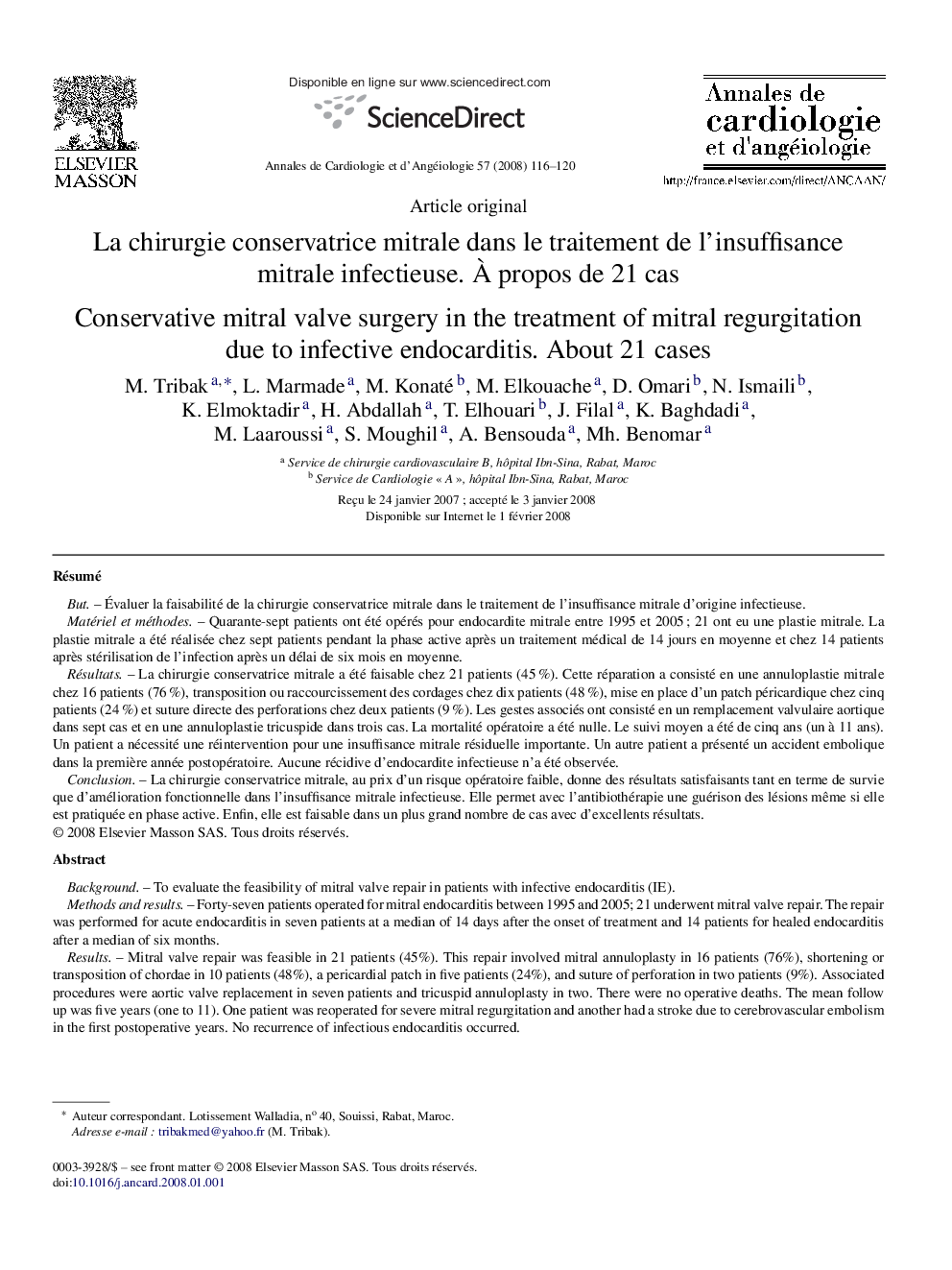| Article ID | Journal | Published Year | Pages | File Type |
|---|---|---|---|---|
| 2869408 | Annales de Cardiologie et d'Angéiologie | 2008 | 5 Pages |
RésuméButÉvaluer la faisabilité de la chirurgie conservatrice mitrale dans le traitement de l’insuffisance mitrale d’origine infectieuse.Matériel et méthodesQuarante-sept patients ont été opérés pour endocardite mitrale entre 1995 et 2005 ; 21 ont eu une plastie mitrale. La plastie mitrale a été réalisée chez sept patients pendant la phase active après un traitement médical de 14 jours en moyenne et chez 14 patients après stérilisation de l’infection après un délai de six mois en moyenne.RésultatsLa chirurgie conservatrice mitrale a été faisable chez 21 patients (45 %). Cette réparation a consisté en une annuloplastie mitrale chez 16 patients (76 %), transposition ou raccourcissement des cordages chez dix patients (48 %), mise en place d’un patch péricardique chez cinq patients (24 %) et suture directe des perforations chez deux patients (9 %). Les gestes associés ont consisté en un remplacement valvulaire aortique dans sept cas et en une annuloplastie tricuspide dans trois cas. La mortalité opératoire a été nulle. Le suivi moyen a été de cinq ans (un à 11 ans). Un patient a nécessité une réintervention pour une insuffisance mitrale résiduelle importante. Un autre patient a présenté un accident embolique dans la première année postopératoire. Aucune récidive d’endocardite infectieuse n’a été observée.ConclusionLa chirurgie conservatrice mitrale, au prix d’un risque opératoire faible, donne des résultats satisfaisants tant en terme de survie que d’amélioration fonctionnelle dans l’insuffisance mitrale infectieuse. Elle permet avec l’antibiothérapie une guérison des lésions même si elle est pratiquée en phase active. Enfin, elle est faisable dans un plus grand nombre de cas avec d’excellents résultats.
BackgroundTo evaluate the feasibility of mitral valve repair in patients with infective endocarditis (IE).Methods and resultsForty-seven patients operated for mitral endocarditis between 1995 and 2005; 21 underwent mitral valve repair. The repair was performed for acute endocarditis in seven patients at a median of 14 days after the onset of treatment and 14 patients for healed endocarditis after a median of six months.ResultsMitral valve repair was feasible in 21 patients (45%). This repair involved mitral annuloplasty in 16 patients (76%), shortening or transposition of chordae in 10 patients (48%), a pericardial patch in five patients (24%), and suture of perforation in two patients (9%). Associated procedures were aortic valve replacement in seven patients and tricuspid annuloplasty in two. There were no operative deaths. The mean follow up was five years (one to 11). One patient was reoperated for severe mitral regurgitation and another had a stroke due to cerebrovascular embolism in the first postoperative years. No recurrence of infectious endocarditis occurred.ConclusionsMitral valve repair in IE gives satisfactory results in terms of survival and symptomatic improvement with a low operative risk. With antibiotic therapy, it provides a cure of mitral lesions even when carried out in the acute phase of endocarditis. Finally, it feasible in several cases with excellent results.
